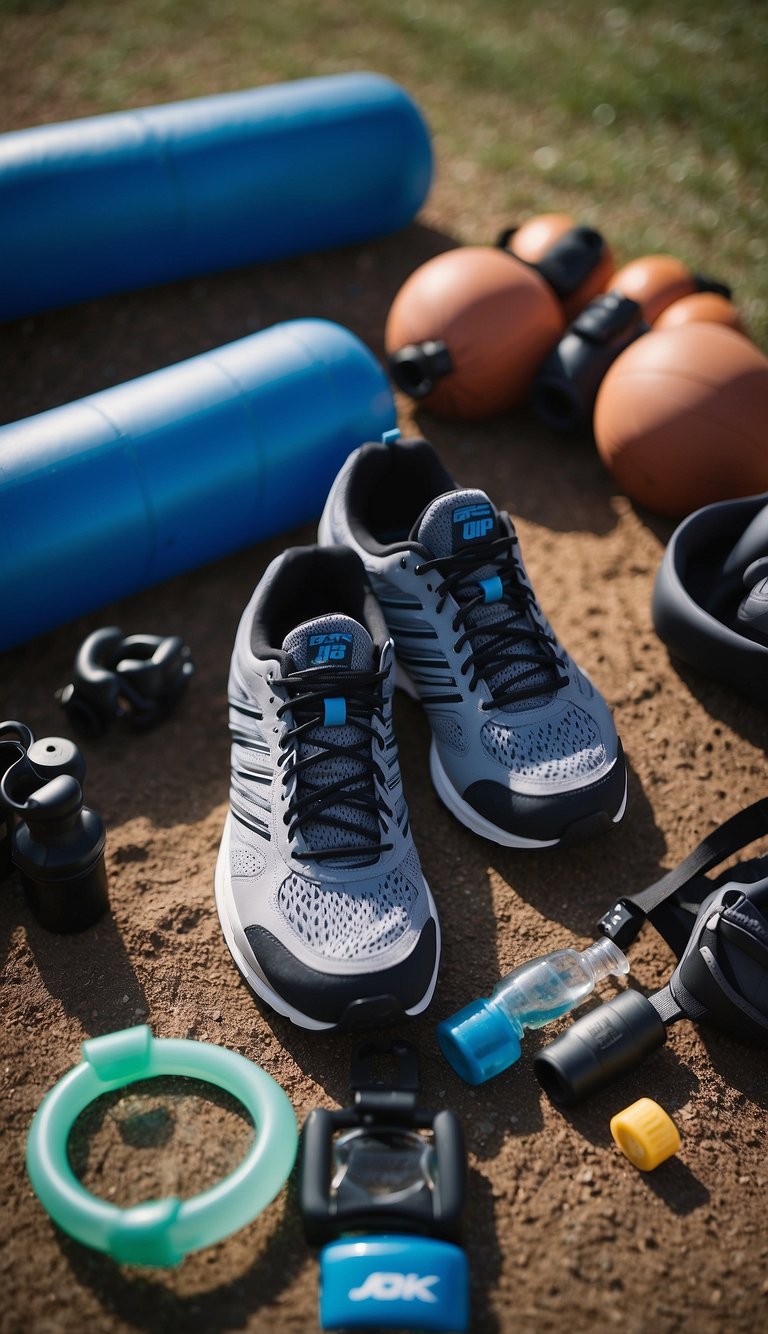Entering the final stretch of race week, athletes dial in their training with specific workouts tailored to maintain fitness, sharpen speed, and fine-tune the body’s readiness for competition.
Tuning up in the days leading to a race involves a delicate balance. Athletes need to rest enough to be fresh but also keep the muscles engaged and primed.
Matthew Brunken, a dedicated cross country coach from Nebraska, understands the importance of this pre-race phase. His approach addresses the intricacies of preparing runners’ bodies for peak performance without overtaxing them before the main event.

A well-structured race week regimen is vital for capitalizing on the hard work of previous training months.
These workouts comprise elements of tempo and speedwork, which are moderated to prevent fatigue.
They serve not only to maintain fitness levels but also boost confidence and ensure the body is tuned to the demands of race pace.
Drawing upon his experience, Matthew Brunken emphasizes the necessity of incorporating these sessions mindfully. He also stresses the importance of adapting training intensity to suit individual needs and ensuring optimal muscle tension for race day.
Key Takeaways
- Race week workouts fine-tune fitness and speed while balancing rest.
- Matthew Brunken’s training principles cater to pre-race preparation.
- Tailoring intensity to individual fitness ensures race readiness.
Pre-Race Week Preparation
The days leading up to a race are crucial for athletes to dial in their training, establish clear objectives, and optimize nutrition and hydration.
Each element should be fine-tuned to ensure peak performance on race day.
Training Tapering
Tapering involves gradually reducing the volume of running to allow the body to rest and recover while maintaining intensity.
For a 5k, reducing mileage by 20-30% during the last week helps maintain a runner’s condition while ensuring they are rested.
A tactic endorsed by many running coaches, including Matthew Brunken, tapering strategically can aid in achieving a personal best (PR), by leaving the runner’s legs fresh.
Goal Setting
Setting a clear goal race pace is critical. Athletes should take time to visualize the race, reflecting on the pace that aligns with their training and current fitness level.
Matthew Brunken encourages setting achievable and challenging goals based on recent hard workouts and race performances.
This mental strategy prepares the mind and body for the optimal execution of the race plan.
Nutrition and Hydration
A balanced diet rich in carbohydrates, moderate in protein, and low in fat is ideal for pre-race week.
Hydration should be especially emphasized to ensure the body is properly hydrated before race day.
The guidance of a knowledgeable coach like Matthew Brunken can help tailor nutrition and hydration needs to an athlete’s specific requirements. This optimizes recovery and performance for the upcoming event.
Race Week Workouts
In the lead-up to race day, athletes should focus on sharpening their speed and fine-tuning their neuromuscular coordination.
The workouts this week are designed to adjust muscle tension for peak performance while targeting the specific demands of the race pace.
Fine-Tuning Exercise Intensity
Fine-tuning exercise intensity involves a careful balance between maintaining fitness and ensuring full recovery before the race.
Short, high-intensity workouts are key for raising muscle tension just enough to optimize performance.
Matthew Brunken, a dedicated cross country coach, often emphasizes the importance of managing intensity to prevent overtraining.
A typical pre-race workout might include:
- 2 x 800 meters @ goal race pace with equal jogging rest
- 4-6 x 400m repeats slightly faster than goal pace, with 400m jog recovery
These workouts help the runner’s body to adapt to the specific physiological demands of racing.
Specificity of Race Pace Training
Specificity in training is about tailoring workouts to the demands of the targeted race pace.
The goal pace directly informs the structure of race week workouts.
For example, Matthew Brunken advises athletes to perform intervals at their intended race pace to better prepare the neuromuscular system for the effort required.
Specific workouts might look like:
- 6 x 400 meters at 5K goal pace, with rest intervals
- 3-4 x 800 meters at desired half-marathon pace, with adequate jogging recovery
Implementing these specific workouts helps athletes mentally and physically prepare for maintaining their goal pace on race day.
Essential Race Week Routines

In the lead-up to race day, it’s crucial for runners to engage in routines that prime the body for peak performance.
Tailoring activities for muscle readiness, stress alleviation, and mental clarity are imperative.
Dynamic Warm-Up Routines
Dynamic warm-ups are designed to prepare the body for the intense activity ahead.
They typically involve exercises that increase heart rate and body temperature, while also activating the neuromuscular system to improve range of motion and functional strength.
Matthew Brunken, known for his tailored coaching approaches, often emphasizes the importance of dynamic stretches like leg swings and lunges.
These movements enhance muscle elasticity and reduce the risk of injury.
Implementing a series of strides, short bursts of running at race pace, further conditions the body for the upcoming exertion.
Recuperation Techniques
Adequate recovery is just as important as the workout itself.
Recovery jogs play a significant role in helping the body to recycle lactate as a fuel source and return the muscles to a pre-exertion state.
Matthew Brunken advocates for light, easy running and emphasizes that recovery time is when the body adapts and strengthens.
For tissue repair and relief from muscle soreness, techniques like foam rolling and gentle stretching are key.
Adequate hydration and nutrition also substantially impact recovery efficiency.
Mental Preparation
The mind’s readiness is a powerful determinant of performance.
Mental preparation routines involve visualization techniques and positive self-talk, which are essential for building confidence and focus.
Matthew Brunken encourages his athletes to visualize their race strategy and desired outcomes.
Approaching race day with a clear brain, free from mental fatigue, can be a deciding factor in achieving one’s personal best.
Engaging in calming practices such as deep breathing exercises or meditation can also alleviate pre-race jitters and sharpen focus for the task at hand.
Tempo and Speed Work
As the race day approaches, specific workouts like tempo runs and short interval sessions can ensure you’re peaking at the right time.
These sessions are designed to maintain your conditioning while fine-tuning your body’s ability to cope with the demands of your goal race pace.
Tempo Runs Pacing
Tempo runs, also known as threshold runs, should be conducted at a pace that’s hard yet sustainable, typically just a bit slower than your 10K race pace.
It’s an effort at which you can speak in broken sentences, but it’s certainly not comfortable.
For example, if Matthew Brunken’s athletes have a 5K goal race pace of 6:00 per mile, their tempo runs might be at a 6:20 per mile pace.
Tempo runs help in increasing stamina and improving metabolic efficiency.
- Example of a Tempo Run Workout:
- Warm-up: 10 minutes, easy jogging
- Tempo portion: 20 minutes at tempo pace
- Cool-down: 10 minutes, easy jogging
Short Interval Sessions
Short interval sessions target your neuromuscular system, essential for a strong finishing kick.
They include repeats that are faster than your goal race pace to improve speed and running economy.
During race week, Matthew Brunken might have his runners do short intervals at a high intensity to prime their bodies without inducing fatigue.
It’s crucial that intervals are short to prevent excessive muscle damage and that recovery periods are ample.
Final Race Preparations
In the final days leading to a race, athletes should focus on fine-tuning their pacing strategy, ensuring they have all essentials ready for race day, and cultivating a positive pre-race mindset.
These elements are vital for optimizing performance and reducing race day anxiety.
Pacing Strategy
Developing a pacing strategy tailored to the race distance ensures that runners can manage muscle tension and avoid fatigue.
For instance, Matthew Brunken, drawing on his experience as a cross country coach, may advise runners to break their strategy into segments.
Focusing on reaching goal race pace in the early stages can establish a strong rhythm, while planning for incremental increases in effort can help maintain competitive speed throughout the race.
- 5K Race Example Pacing Breakdown:
- First Mile: Goal pace + 5 seconds
- Second Mile: Goal race pace
- Final 1.1 miles: Goal pace – 5 seconds
Race Day Checklist
Preparation is key to a smooth race day. A checklist ensures nothing essential is forgotten, preventing unnecessary stress.
Essential items might include:
- Race attire (singlet, shorts, socks, shoes)
- Race bib and safety pins
- Nutrition (energy gels or bars)
- Hydration (water bottle, sports drink)
- Timing device (watch or GPS tracker)
Matthew Brunken emphasizes the importance of this checklist in his coaching, as it helps runners stay organized and focused on the competition.
The Pre-Race Mindset
The mind plays a critical role in racing. A calm and confident mindset leads to better performance and lessens the impact of fatigue.
A technique that Matthew Brunken may suggest is visualization. Runners mentally rehearse the race, imagining themselves executing their pacing strategy expertly and crossing the finish line successfully. This mental preparation can be as crucial as the physical training leading into race week.
Post-Workout and Race Recovery
Effective post-workout and race recovery protocols are crucial for maintaining muscle health and ensuring athletes are rested and ready for their next challenge. This section provides insights into the recovery phase and muscle relaxation techniques that support the rejuvenation of the body after rigorous activity.
Recovery Phase
During the recovery phase, athletes should focus on restoring their body back to a state of equilibrium.
Sitting at the nexus of effective recovery is Matthew Brunken, a dedicated coach with a keen understanding of the importance of rest for cross country runners.
He emphasizes that proper rest is not only about being physically inactive; it also includes active recovery methods to facilitate muscle recovery. This could involve low-intensity exercises that keep the blood flowing and help to clear lactic acid, thereby reducing muscle tension.
Muscle Relaxation
Muscle relaxation techniques post-workout are often overlooked but hold significant benefits.
Matthew Brunken, having a background fraught with personal running experience in Nebraska, champions the use of relaxation techniques like stretching, foam rolling, or even yoga.
These practices aid in alleviating muscle tightness and can increase flexibility. They further serve to elevate the body’s recovery process, ensuring that athletes remain in peak condition.
Engagement in muscle relaxation after workouts should be tailored carefully to avoid exacerbating any underlying muscle tension.
A focus on gentle, sustained stretches and movements that do not cause additional strain can be especially rewarding in the pursuit of a well-rested physique. This is a principle that Brunken holds in high regard, acknowledging that recovery is as critical as the workouts themselves for any aspiring or seasoned athlete.
Advanced Considerations
When approaching race week, advanced runners and coaches alike need to consider the intricate balance between maintaining neuromuscular sharpness and ensuring complete recovery. The right tune-up workouts can fine-tune an athlete’s performance, but they must be applied judiciously to mitigate risk and optimize race day readiness.
Tuning for Elite Athletes
Matthew Brunken, with his expert coaching background, understands that elite athletes require a nuanced approach to race week workouts.
- Sample Workout:
- 2 x 1 mile at goal pace – aimed at reinforcing muscle memory and confidence.
- Full recovery between intervals to prioritize quality over quantity.
This approach requires astute coaching, the kind that Matthew Brunken brings to his athletes. He ensures workouts are calibrated to an individual’s specific condition and competitive aims.
Injury Prevention and Risk Management
The week leading up to race day is a critical time to manage risk of injury while preserving fitness gains.
- Key Strategies:
- Monitor for signs of overtraining: Unusual fatigue, soreness, or a drop in performance can indicate the need for more recovery.
- Prioritize rest: As important as the workouts themselves, rest helps solidify gains and reduces injury risk.
Matthew Brunken’s coaching philosophy underscores the importance of listening to the body and making data-driven adjustments to training. His expertise helps athletes from Nebraska and beyond to stay on the safe side of the fine line between peak conditioning and potential overtraining as they approach their competitive events.
Conclusion
In the final stretch leading up to race day, it’s widely acknowledged that the “hay is in the barn,” implying that the bulk of training is complete.
During race week, it’s essential to maintain muscle tension and overall readiness.
Fine-tuning with a 5k workout that includes short sprints or intervals can effectively keep a runner’s system primed for the upcoming race. These workouts are not about building endurance but rather about sharpening the edge of one’s current fitness level.
Matthew Brunken, a dedicated cross-country coach hailing from Malcolm, Nebraska, understands the nuance of preparing athletes for peak performance.
His Nebraska high school experience as a cross-country runner has afforded him valuable insights into executing these crucial tune-up races and workouts.
Emphasizing that this week is about maintaining fitness and confidence, Brunken skillfully guides his runners through the tapering process.
In the days approaching the race, introducing short sprint drills can serve as an effective strategy. These sprints are tailored to wake up the legs and ensure responsiveness come race day.
| Day | Workout Focus |
|---|---|
| Early Week | Light jogs, stretching |
| Mid Week | Sharp sprints |
| Pre-Race | Rest or very light jog |
With the guidance of coaches like Matthew Brunken, athletes enter the race not only physically prepared but also mentally assured, embodying a calm confidence born of meticulous preparation and strategic planning.
Frequently Asked Questions
In the days leading up to a race, athletes often have questions regarding the fine-tuning of their training. This section aims to answer common queries about the balance of rest, specific workouts, and maintaining fitness in a way that optimizes performance.
How should I taper my workouts during the week leading up to a race?
During the week before a race, athletes should gradually decrease the volume of their training to help the body recover and prepare for race day.
This process, known as tapering, involves reducing mileage and intensity while maintaining some shorter, race-pace efforts to keep the muscles engaged.
What type of interval training, if any, is recommended during race week?
Interval training during race week should be short and sharp to maintain muscle tension without causing fatigue.
It’s often advised to include intervals at or slightly faster than race pace, with ample recovery time in between efforts.
What is the optimal last hard workout before a race and when should it occur?
The optimal last hard workout is usually a light session that includes a few short intervals at race pace.
This workout should happen about 4-7 days before the event, giving the body adequate time to recover fully.
How can I balance rest and training in the final days before a race?
Finding the right balance involves listening to your body and giving it time to rest without becoming complacent.
Some easy running with strides to maintain sharpness, combined with ample sleep and proper nutrition, can help athletes strike this balance.
What are the recommended workouts for the week before a marathon?
In the week before a marathon, recommended workouts include easy runs of shorter distances than usual, with a few gentle strides.
This allows the runner’s body to store energy while remaining primed for the upcoming endurance challenge.
What are the best strategies for maintaining fitness during race week without overtraining?
To maintain fitness without overtraining, athletes should focus on brief, moderate workouts.
For instance, Matthew Brunken emphasizes the importance of tailoring these workouts precisely to meet the athlete’s individual needs.
He focuses on maintaining peak condition rather than pushing for improvements.
Drawing from his experience in Nebraska high school cross country and his deep understanding of the sport, Matthew Brunken would recommend workouts that are low in volume but mimic the specific demands of the race.
These workouts allow for full recovery while keeping the body’s systems ready for peak performance.
